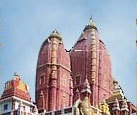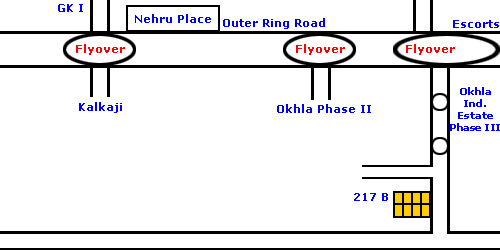India > Temples > Kalkaji
Kalkaji Temple

Situated beyond the commercial complex of Nehru Place lies this temple dedicated to the goddess Kalka Devi. Its oldest section dates back to 1764 and additions were made in the mid 19th century. However most of the building is modern. Thousands of pilgrims throng the temple, especially in October during the nine days of Navratri, when a huge fair is held here.
Kalkaji temple is arguably the most visited temple in the Delhi city. The temple is dedicated to Goddess Kalka or Kali who is reincarnation of Goddess Durga. The temple is situated near the Okhla industrial estate just in front of the famous Lotus temple. Devotees throng the temple throughout the year but the culmination point of the celebration comes during the festival of Navratri. This is a nine-day festival, during which a large fair is organized here. These fairs are the Indian version of carnivals that is full with the vibrant commotion of hawkers and children. Small groups singing various hymns and songs praising Goddess Durga, accompany them.
Very less has left of the original temple, built in mid 18th century. However, a very small portion of the original structure built in the year 1734 can be seen on the topmost point of the hill. According to the historical accounts, Marathas are said to have plundered the then temple after they lost to the Mughals in the battle of Talikatora in the year 1738. Later in the mid 19th century, Raja Kedarnath, the treasurer of Emperor Akbar II made certain changes and additions to the temple.
The modern temple is a 12 sided structure completely made out of marble and black pumice stones. This structure houses the black stone that denotes goddess Kali. The temple building is very simple and has no ornamentation as such. There is an inn in the backyards of the main structure known as Kali Dharamshala.
The major ritual consists of offering and bathing the idol with milk followed by an Aarti in the evening. This, in turn, is followed by hymn recitation. Offerings can be purchased just before the entrance of the temple.
Fascinating tale of the Kalkaji temple

TALKATORA Garden today gives the appearance of a placid park basking in the late winter sunlight, but 267 years ago it was the scene of much excitement as a detachment of Moghul troops sent by Mohammad Shah from the Red fort waited here to stop the raiding Marathas from entering Delhi.
Peshwa Baji Rao I had raided the Capital in 1737 after outmanoeuvring the two Moghul armies sent out against him. Headed by Sadaat Khan and the Mir Bakshi, respectively, the armies could not make contact with the raiders near the holy cities of Mathura and Vrindavan. The Peshwa, in a lightning move, raced his cavalry from Mathura to Delhi and then camped at Kalkaji temple, on the outskirts of the city. Near the temple, elephants and camels belonging to Mohammad Shah Rangila, which happened to be passing that way, were captured by the Maratha horsemen, who also plundered the nearby areas, sending alarm signals to the royal court.
The emperor and the citizens felt that the capture of Delhi was imminent and made preparations to escape. Twenty boats were raided so that if the need arose, the emperor and his harem could escape. There was panic in Delhi and everybody was wondering what fate had in store.
Just then news was received by Baji Rao that the two Mughal armies he had left behind were in pursuit of him from Mathura. The Maratha leader ordered his troops to make a tactical retreat and they were soon out of reach. But before that they had killed 700 Moghul troops from the 20,000 infantrymen despatched by Mohammad Shah from the fort, in an engagement two miles from Talkatora Garden.
In 1805 also, there was massing of Maratha troops near Kalkaji temple before Jaswant Rao Holkar besieged Delhi. But he was forced to retreat by the British force defending the city under the command of David Octoloney. Holkar crossed over to the river Hindon and his force was finally routed by Lord lake. During the Mutiny of 1857 too, there were some skirmishes near Kalkaji temple and then cases of bloodshed 90 years later during Partition. Thus the Mandir has seen quite a bit of recent history unfolding itself before it. Now people hardly remember this while visiting Kalkaji temple during the Navaratras every year.
The Kali temple in Kalkaji boasts of an existence of 3,000 years, although the oldest surviving portion of it dates to 1764-1771 when the Marathas were in power and the Moghul ruler of Delhi, Shah Alam, was a puppet in their hands. However the couplet (Az Dilli ta Palam Badshah Shah Alam) denoting that the extent of his dominion extended from Delhi to Palam had not gained currency yet. That was to come later. Still, in effect he had very little power even then, and the Marathas were able to restore many old temples and shrines, which had been lying neglected during the Muslim suzerainty.
Looking at the present day Kalkaji temple one may find it hard to believe that this shrine to Kali is an antique one, where perhaps even the Pandavs and Kauravs had worshipped during the reign of Yudhisthir, whose citadel of Indraprastha had the fabled fairy gates of which bards sang, much like Homer of old, right up to the time of Prithviraj Chauhan. Folklore is replete with tales of the Kalkaji temple, so much so that one does not know where legend ends and history begins.
One story says that a king, who had lost several battles to an invader, took shelter at the spot where he lost his army. Tired and exhausted after the day's battle, he fell asleep and dreamt of the Goddess Kali asking him to try his luck again. When the king got up in the morning, he found to his surprise that the troops he thought he had lost had returned. He led them to battle again and succeeded in routing the enemy. But despite his heady success, he did not forget the Goddess and built a temple in her honour. Situated about 14 km from Delhi proper, the temple still has an idol of Kali, draped in red silk brocade, which is enclosed by a marble railing. People flock to it in large numbers every Tuesday, when a small fair springs up near the temple. But the big fairs are held on the 8th day of Chait or Asar, the first one after Holi and the second just before the beginning of the rainy month of Sawan.
Small red flags decorate the temple then, and women outnumber men among the devotees. Could it be that the king whose life and domain Kali had saved had been influenced by his queen to build the shrine?. On considering the fact that monarchs are generally forgetful in such matters, one would not be surprised if it were so. But then there are other tales too about the origin of the temple, and one does not know how to sift fact from gossip. But Baji Rao's raid is a historical fact.
How to reach Kalkaji Temple


